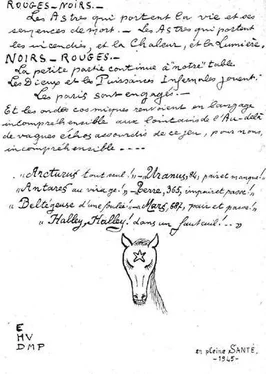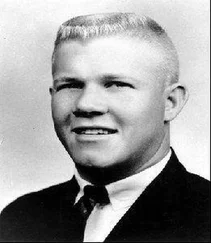German authorities, by contrast, were being surprisingly aloof. After the initial order to arrest Petiot, the Gestapo had not yet obstructed, facilitated, or otherwise directly interfered in the search. It turned out, however, that a suboffice of the Gestapo had quite a file on Marcel Petiot. On March 15, 1944, this dossier was forwarded to Commissaire Massu.
12.
THE GESTAPO FILE
HE SAID TO ME THAT HE WOULD SOON BE SHOT AND THAT, IN THIS CASE, HE ONLY REGRETTED ONE THING: HE HAD NOT DONE ENOUGH.
—Renée Guschinow, describing a conversation with Marcel Petiot
THE Gestapo had certainly known Marcel Petiot. As Massu now learned to his astonishment, the German secret police had suspected him of operating a secret organization that helped Jews, downed Allied pilots, and deserting German soldiers escape Occupied Paris. According to one of the estimated twenty thousand Parisian informers, this clandestine organization was headquartered in a beauty salon at 25 rue des Mathurins, a street known for its many theaters and brothels, located just around the corner from the grand department stores Galeries Lafayette and Printemps, on the Boulevard Haussmann.
The hair salon, decorated in the faded elegance of a previous era, was run by Raoul Fourrier, a short, stocky sixty-one-year-old hairdresser and wigmaker. He was assisted by his friend, the fifty-six-year-old makeup artist and former cabaret performer Edmond Marcel Pintard, who had acted under the stage name Francinet and played small roles in a number of silent and early talkie films. Pintard’s task in the organization was to frequent bars, bistros, cafés, and nightclubs, looking for people interested in leaving Nazi-occupied Paris. Once he had established contact, he would refer potential clients to the hair salon, where details of passage would be arranged.
Both Fourrier and Pintard were believed to be serving under Marcel Petiot, who, to Massu’s further surprise, had actually been arrested by the Gestapo and held in prison for almost eight months. The German file detailed the campaign that the secret police had waged in the spring of 1943 to capture Petiot, the rumored Resistance leader and enemy of the Third Reich.
One branch of the Gestapo was particularly involved in the pursuit: IV B-4. In the Nazi bureaucracy of terror, the Gestapo was Department IV of the SS Reich Security Main Office (Reichssicherheitshauptsamt). Section B dealt with “sects” and subsection 4 with Jewish Affairs. Since March 1942, Gestapo IV B-4 had worked in every stage of the Nazis’ “Final Solution”: arresting Jews, seizing their property, and deporting them to death camps in the east. The office in Paris, like all other branches in Occupied Europe, answered to Adolf Eichmann in Berlin.
A commissioner in the bureau, Dr. Robert Jodkum, a solidly built man in his late fifties with a crew cut, thick glasses, and pale blue eyes, was anxious to obey. As former secretary and interpreter for SS Hauptsturmführer Theo Dannecker, the resident Nazi “Jewish expert” in Paris, Jodkum now served under Dannecker’s successor, SS Obersturmführer Heinz Röthke. Although also nominally under Sturmbannführer Loperz, Jodkum was effectively in charge of this anti-Jewish service.
Jodkum, a former pork butcher, was one of the rare civilians to obtain such prominence in the Reich Security Main Office, which had been established in 1939 to bring together the seven departments of the SS under one security office. Jodkum was, moreover, under pressure for his alleged leniency on the Jewish question. Apparently he decided to prove himself with an energetic pursuit of Petiot’s rumored escape organization, believed to be engaged in the “contraband of persons.”
Jodkum’s plan was not simply to storm the hair salon and start arresting people. Instead he decided to send in a plant, or mouton (literally a sheep or stool pigeon), who would pose as a man desperate to leave Paris and seeking the organization’s services. That way, the Gestapo could infiltrate the organization, learn its procedures, and then, at the opportune moment, seize its ringleaders, intermediaries, files, and assets. Plotting carefully, Jodkum selected Yvan Dreyfus for this role. Dreyfus was a thirty-five-year-old former silk merchant from a Jewish Alsatian family who had come to Jodkum’s attention due to an unfortunate turn of events.
Back in 1939, when the war began, Dreyfus was working in the United States, where he had previously studied engineering. His friends, concerned about the danger to him as a Jew, urged him to stay there in safety. Dreyfus had resisted. “I am a Frenchman,” he said, unable to abandon his country in a time of need. He returned home to France and enlisted in the army. He arrived just before the German Occupation.
After the army was demobilized, Dreyfus found that the silk business had been decimated, and he turned to selling radios and electronic equipment in Lyon. In early 1943, wanting to join de Gaulle’s Free French Army in London, Dreyfus decided to hire a passeur , or guide, to lead him and four of his cousins out of Occupied France. But they were betrayed and the men were captured at Montpellier, imprisoned at Nîmes, and eventually sent to Compiègne, a notorious transit stop on the way to the Nazi death camps at Dachau and Buchenwald.
Hearing of his arrest, the Dreyfus family of course wanted to buy his release, if it was at all possible, and sure enough, a French lawyer with the right connections appeared. This was Jean Guélin, a former Lyon attorney and mayor of a small commune in Deux-Sèvres, until he lost his position for black market dealings. Now in Paris, Guélin operated a lucrative purchasing agency that sold scrap iron to Occupation authorities. He also engaged in a number of other ventures, including directing the Théâtre des Nouveautés, not far from Fourrier’s hair salon, and also for the last five months, with his colleague Marcel Dequeker, the Théâtre Édouard VII. Both Guélin’s restaurant, Zardas on rue de Sèze, and his apartment on rue de Longchamp had been confiscated from Jewish victims.
Well informed of the wealth of the Dreyfus family, Guélin approached the Gestapo commissioner with a proposal to release the prisoner. A ransom, Guélin added, could be split three ways between Jodkum, the Third Reich, and himself.
Such ransoming of individual Jews was on the increase in both Occupied France and Europe. Six months earlier, Heinrich Himmler had (with Adolf Hitler’s support) allowed IV B-4 offices to free certain people deemed a low “security risk” in exchange for a fee. Some offices in Europe had drawn up lists of rich Jews to ransom, such as the Frielingsdorfs Liste of the Netherlands’ IV B-4. At least four hundred individual Jews purchased their freedom in that country alone, raising a total of 35 million Swiss francs. The money was in part used to finance Third Reich operations as well as line the pockets of Nazi officials who brokered the deals.
Jodkum accepted the proposal to sell Dreyfus’s release, but added the stipulation that the prisoner had to perform a service and infiltrate the escape route. From previous surveillance, the Gestapo knew that the underground organization could easily be contacted in the cafés and bars of the 9th and 10th arrondissements. Getting accepted, however, was more difficult. The organization was believed to take many safety precautions, including rigorous background checks, conducted allegedly by a French police officer, and a number of interviews, to ensure that a potential client posed no security threat.
If the applicant gained admission, the time and date of the departure would be set at a later meeting at an undisclosed location. The traveler would usually be notified three or four days in advance. At the time of the rendezvous, a member of the escape organization would meet the client and escort him or her to a secret hideaway, thought by Gestapo informers to be a “hotel or a doctor’s office.” All ties with family and friends were at this point severed. Departure was believed to take place about every three weeks.
Читать дальше












